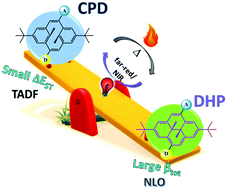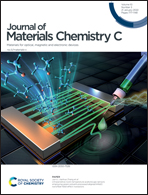The second-order NLO and TADF properties of a donor–acceptor dihydropyrene–cyclophanediene system: the impact of molecular architecture and polarizable environment†
Abstract
The electro-optical properties (nonlinear optical (NLO) and thermally activated delayed fluorescence (TADF) properties) of a negative T-type dihydropyrene (DHP)-cyclophanediene (CPD) photoswitch were studied systematically in this work. An interesting “seesaw” phenomenon between the two properties was revealed during the reversible process of configuration transformation between DHP and CPD derivatives. The DHP derivative “declines” due to a larger first hyperpolarizability β, while the CPD derivative “rises” because of a smaller singlet–triplet energy gap (ΔEST). The DHP derivative displays excellent NLO properties due to the extended π-conjugation, more planar molecular structure, lower transition energy and larger separate distributions of the first hyperpolarizability density. The CPD derivative has a smaller singlet–triplet energy gap (ΔEST) because of the obvious spatial separation of HOMO and LUMO. Notably, the CPD derivative shows potential TADF properties (vertical ΔEST < 0.1 eV) in a solid-state environment, which can be attributed to the fact that the dominant LE characteristics in the gas phase were switched to 1CT and 3CT in the polarizable environment. In addition, the substituents at positions (2, 7) of the DHP derivative are conducive to obtaining a greater NLO response. The substituents at positions (4, 9) of the CPD derivative can obtain a smaller ΔEST value. Introducing a polarizable environment is an effective method to improve electro-optical properties. Overall, we hope that the present work can provide a route towards the rational design of such a D–A system for novel functional electro-optical materials.



 Please wait while we load your content...
Please wait while we load your content...